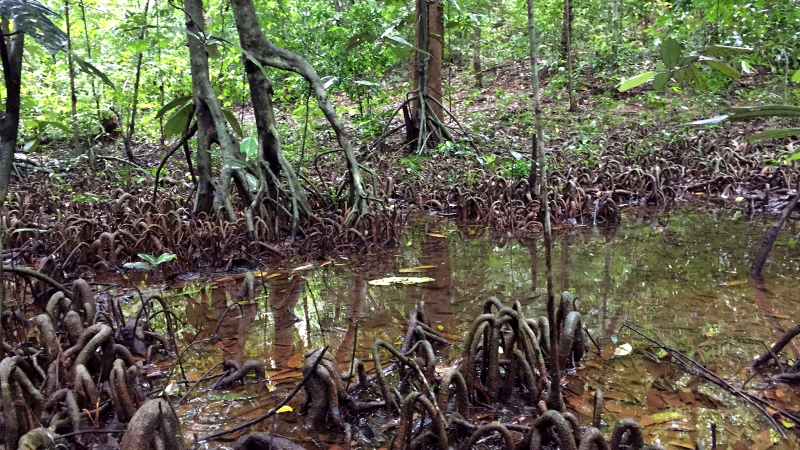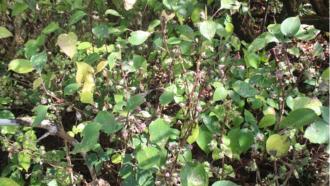
A Myristica swamp in the Western Ghat mountains, Karnataka. Photograph by Mital Thacker
The Western Ghat mountains, off the western coastline of the Indian peninsula, are a biodiversity hotspot. This region is home to hundreds of species of plants and animals not found anywhere else in the world. Of the many ecosystems found in this region, one of the unique ones is the Myristica swamps. These are water-saturated areas with an abundance of trees from the Myristicaceae family, known as ramapathre in Kannada (ರಾಮಪತ್ರೆ ಜಾತಿ). This is a lineage of plants that evolved approximately 15–20 million years ago and has changed very little since then. A recent paper comprehensively surveyed the Myristica swamps of the Western Ghats in Karnataka, focusing on the diversity of diatom species as an indicator of the ecological conditions in the swamps.
Diatoms are tiny algae made of a single cell surrounded by transparent silica cell-wall. Like plants, they use sunlight to perform photosynthesis and produce the energy they need to live. They are at the base of the food web; they are eaten by larger organisms and sustain their local environment. They are also incredibly sensitive to changes in the water quality of their environment. They preserve beautifully in lake sediments, which makes them good indicators of their environment’s past and present conditions.
The authors of the paper described the diversity of diatom species in 17 Myristica swamps in Karnataka. They examined the relationship between that diversity and the environment of the swamp itself. Their question was: what does the diversity of diatom species in a swamp environment tell us about that environment and its general health? The study was published in the open-access journal Diversity and funded by the Ministry of Earth Sciences (MoES), Government of India under the Paleoclimate program.
The researchers found 91 different species of diatoms, 44 of which seemed to be new to science and only found in Myristica swamps. Cataloguing new species in itself is an important contribution as there is sparse documentation of diatom species found in tropical countries like India, compared to species in European countries.
 Nine of 91 different species of Diatoms collected by the authors of the study
Nine of 91 different species of Diatoms collected by the authors of the study
The researchers used three different statistical measures to quantify the diversity of diatom species at each swamp: the Shannon Index, Simpson’s Diversity Index (specifically the Gini-Simpson Index) and Pielou’s Evenness. These indices measure how many different species are found in an environment and how abundant they are relative to each other in slightly different ways. Considering all three indices together yielded a comprehensive picture of the diversity of diatoms across all the swamps that were studied.
Next, the researchers compared the diversity of the diatom species with the properties of the water in the swamp to see which of these properties affected diversity the most: the pH (acidity) and electrical conductivity of the water; how much oxygen was dissolved in the water; and the levels of dissolved nutrients in the water, specifically nitrates and phosphates. The analyses showed that the pH, dissolved oxygen content and electrical conductivity of the water in the swamps had the biggest effect on exactly which diatom species were found.
Like much of the forests in the Western Ghats, the Myristica swamps are under threat from human activity. The properties of the water that affect diatom diversity are all susceptible to such human-caused environmental changes, making diatoms an important indicator of the health of their ecosystems. Furthermore, in those swamps that were known to be disturbed by human activities, the number of diatom species was lower than in undisturbed swamps.
Dr Karthick Balasubramanian, the paper’s senior author, explains, “These swamps have got into trouble recently, in the last 30–40 years, because they can retain water throughout the year. People want to divert the water from the swamp to agricultural fields. These swamps always occur in valleys, which are very good for areca nut plantations.”
Damage to Myristica swamps affects more than just diatoms.
Dr Karthick explains, “[These swamps] are refugia for many endemic frogs and insects, like dragonflies and damselflies. We don’t know what is living there! Whatever happens, we need to protect these environments.”
When it comes to public support for conservation efforts, living creatures that we can only see with a microscope don’t exert the same emotional pull as large animals as tigers or pandas do. However, up close, diatoms are just as captivating as any tiger – they look like tiny crystals, beautiful in their symmetry and astonishingly diverse in their range of shapes. Conserving diatoms means conserving their habitats, which Mital Thacker, the study’s first author, describes as “charismatic”.
“It’s a really beautiful ecosystem,” she adds. “I will never forget working there, not for the rest of my life.”
This article has been run past the researchers, whose work is covered, to ensure accuracy.






